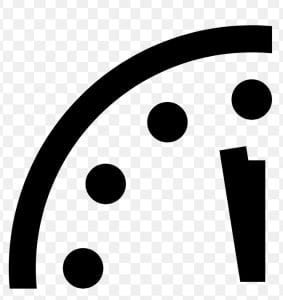Founded in 1945 by Albert Einstein, J. Robert Oppenheimer, and University of Chicago scientists who helped develop the first atomic weapons in the Manhattan Project, the Bulletin of the Atomic Scientists created the Doomsday Clock two years later, using the imagery of apocalypse (midnight) and the contemporary idiom of nuclear explosion (countdown to zero) to convey threats to humanity and the planet. The Doomsday Clock is set every year by the Bulletin’s Science and Security Board in consultation with its Board of Sponsors, which includes nine Nobel laureates. The Clock has become a universally recognized indicator of the world’s vulnerability to global catastrophe caused by man-made technologies.
 The Doomsday Clock was set at two minutes to midnight in 2019 and at 100 seconds to midnight in 2022. Last year, we expressed our heightened concern by moving the Clock to 90 seconds to midnight—the closest to global catastrophe it has ever been—in large part because of Russian threats to use nuclear weapons in the war in Ukraine. How does this affect my book. Well, during the editorial phase, I had to adjust the Doomsday Clock in my manuscript too. Check out this extract:
The Doomsday Clock was set at two minutes to midnight in 2019 and at 100 seconds to midnight in 2022. Last year, we expressed our heightened concern by moving the Clock to 90 seconds to midnight—the closest to global catastrophe it has ever been—in large part because of Russian threats to use nuclear weapons in the war in Ukraine. How does this affect my book. Well, during the editorial phase, I had to adjust the Doomsday Clock in my manuscript too. Check out this extract:
[“Why MIT?” she repeated.
“My reason for choosing MIT was simple and complex.”
Claudine laughed. “Oh, that’s funny. What do you mean?”
“The simple answer is Jay Forrester.”
“Jay Forrester?” she asked. “I’ve never heard of him.”
“Yes, Mr. Forrester was a smart guy who pioneered work on digital computers here at MIT. He’s famous for his Global Sustainability Model, predicting that civilization would destroy the world in 2040. And what’s remarkable, is that his conclusion was the same as the one made by Isaac Newton in 1704. Their findings are confirmed by the Doomsday Clock.”
“Which is?”
“The time when our planet implodes. The Doomsday Clock is set at ninety seconds to midnight. Our time is almost up, and Armageddon will be upon us unless we do something radical to change the world.”
Claudine smiled. “That’s why I’m here.”]
